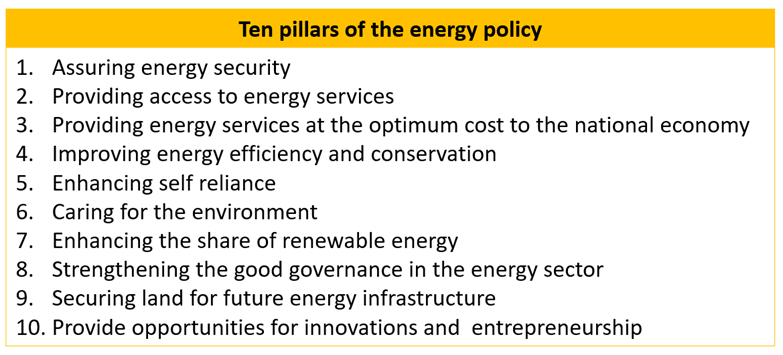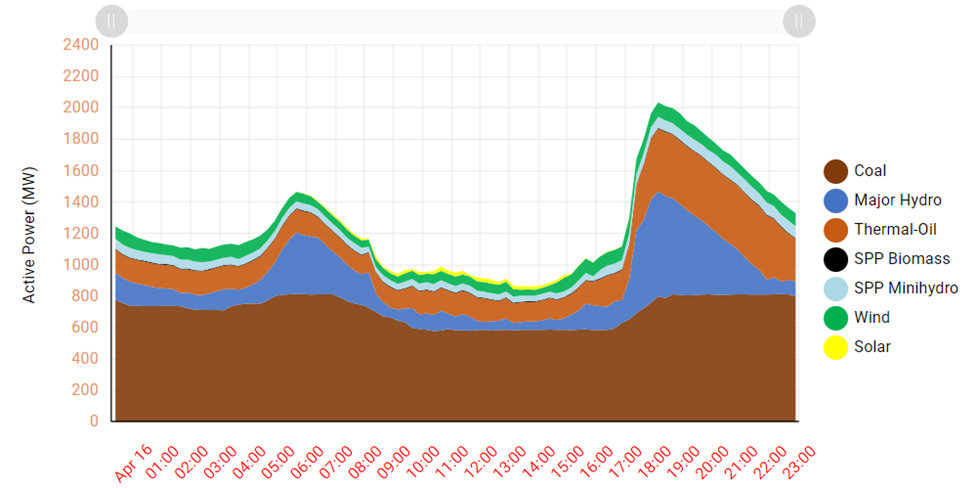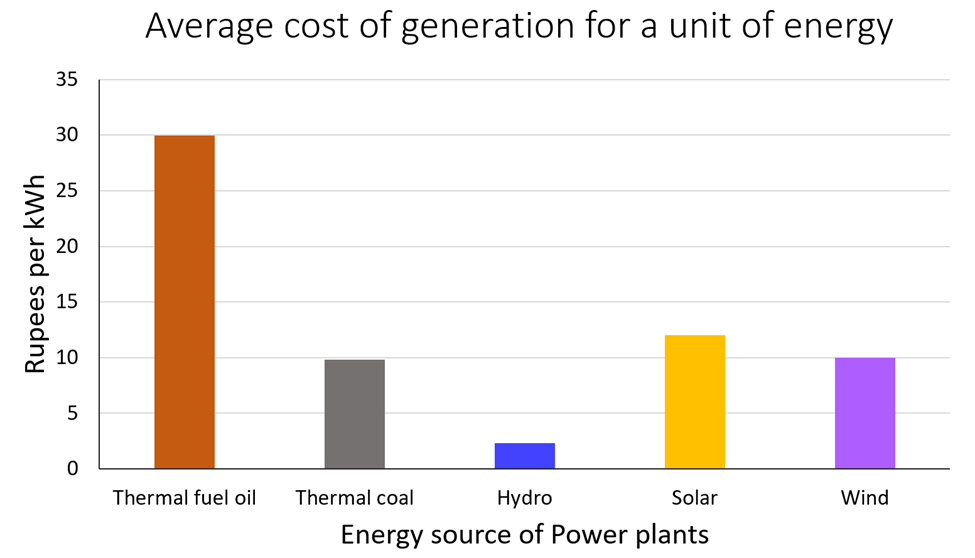Establishing Energy Security Towards an Energy Empowered Society
BY Eng. M. M. I. D. Manthilake, Eng. H. P. Karunathilake, Eng. H. K. G. Punchihewa and Eng. A. S. Galhenage
Introduction
Sri Lanka is currently experiencing perhaps the most serious energy crisis in its history. The generation system is facing difficulties in maintaining a continuous supply of electricity to industries and households. Power cuts lasting 10-13 hours a day (50% of the day) have become commonplace, disrupting the normal functioning of lives and industrial activities. With the growth in the national energy demand, Sri Lanka gradually came to rely on imported fossil fuels to supply its energy needs starting from the early 1990s. With the current economic crisis and the associated draining of foreign exchange reserves, this reliance has threatened the energy security of Sri Lanka as it became challenging to procure the fuel needed for electricity generation. Unfortunately, there is no short-term solution to this situation, as around 64% of Sri Lanka’s electricity supply is generated from imported coal and oil. Hydropower, the main indigenous energy source, is affected by the dual issues of significant fluctuations in availability and competing demand for the water from the agriculture sector.
Yet, energy is a basic need of the current human civilization, and it is inherently entwined with economic and social development. According to the United Nations Human Development Index, the human capital of Sri Lanka scores over 0.7 indicating a knowledgeable society which is the greatest asset for the development of a country. As per the CEB statistical digest 2020, the annual Gross Domestic Production (GDP) per capita in the year 2020 is equivalent to USD 3852. It has been estimated that, in order to produce one million LKR of the GDP, 470 GJ of energy is used in 2017.
Sri Lanka energy policy
The National Energy Policy, gazetted on 9th August 2019, presents three sectors of demands as an ‘Energy Trilemma’. These sectors are security, equity, and sustainability in terms of energy. The word ‘trilemma’ usually describes a situation of having to choose one from equally undesired three options. Yet, it is clear that the aspects mentioned in the energy trilemma are all desirable and necessary qualities when it comes to the energy supply. Therefore, it is not actually a trilemma. Given below are the ten pillars on which the national energy policy is founded, to ensure the three dimensions (or the triple bottom line) of sustainability: society, economy, and environment, while fulfilling the energy ‘trilemma’.

National energy supply
Sri Lanka has a power generation capacity of 4217 MW (CEB 2953 MW and independent producers 1264 MW), and the system produces nearly 15,000 GWh (= 15,000 X 3600 GJ = 54000 TJ) of energy a year (CEB statistical digest 2020). The system is dependent on 25 % major hydro, 37 % coal, 27 % other thermal (mainly diesel), 6.7 % mini hydro, 2.5 % solar and 0.05 % wind as shown in Figure 1, based on the CEB Annual report 2020.

Figure 1: National energy supply
Consider the electric power consumption curve of Sri Lanka on 16th April 2022 shown in Figure 2 below as an example. At present, the maximum power demand of the country is just over 2000 MW and the daily energy consumption is around 30 GWh. The baseline of power demand, which is around 900 MW, is chiefly supplied by the Norochcholai coal power plant which accounts for 810 MW (The home load is 90 MW) and the Ceylon Electricity Board (CEB) owned thermal power plants.

Figure 2: Load curve on Saturday 16th April 2022 (SPP stands for Small Power producers).
The remaining load is supplied by thermal power plants owned by the private sector such as the Lakdhanavi (54 MW) and Yugadhanavi (300 MW). Hydro plants also handle a considerable share of the baseload, and they are also utilized to supply the variable load. In addition, hydro plants are instrumental in frequency control of the system (i.e., maintain the frequency at 50 Hz) owing to their flexibility that allows continuous control of the water flow through the turbines.
The grid connected rooftop solar and solar farms, and wind farms also supply electricity to the system. However, these two sources are non-dispatchable in the absence of storage, and typically show fluctuations in energy production due to the variability in solar irradiation and availability of wind. This variability is also compensated by the hydro power plants. Currently, the contribution from hydro power plants to the annual energy supply is nearly 25 % (www.ceb.lk).
Cost of supplying power
According to Figure 1 above, Thermal coal and Thermal oil power plants supply over sixty percent of the power demand of the country. As mentioned earlier, the fuel required for thermal power generation is imported. According to the annual report of the CEB (2020), the overall average cost of generating a unit of electrical energy (1 kWh) is LKR 9.90. Figure 3 below compares the average cost of generating a unit of electricity by each power source based on accumulated energy generation and the accumulated expenses for energy generation that includes the cost of fuel.

Figure 3: A comparison of average electricity generation cost by source, per kWh
Although the cost of generating solar and wind power (from International Renewable Energy Agency: https://www.irena.org) is comparable to the cost of generating power from thermal coal, there are no emissions during the operation of the former and no need to import fuel by spending foreign exchange. However, on the flip side, the power generation equipment and infrastructure components are almost exclusively imported for the RE technologies, due the lack of adequate technology transfer and local industry development within Sri Lanka.
It can be observed that the overall average generation cost is maintained below LKR 10 owing to the 25 % contribution from the hydro power plants. The cumulative expenditure for the thermal power plants as at 2020 is nearly LKR 108 billion since their commencement of operation while that for the hydro power plants is LKR 9 billion. The main component of this expenditure is the cost to import fuel for the thermal power plants. It can also be noted that the cost of a unit of electricity generated from thermal oil is almost three times the cost of a coal-based electricity unit and ten times that of a hydro-based electricity unit. Due to the delays in constructing coal power plants in SL, the energy sector has had to spend very high costs on thermal oil power generation. The drought in 2019 meant that hydropower generation decreased greatly, leading to higher reliance on thermal sources. This led to an increase in the average cost of production of a unit of electricity, which ultimately translated to a loss of billions of Rupees for the national economy.
The present energy crisis where long-duration power cuts are experienced is mainly due to the non-availability of funds to pay for the fuel that is needed to generate electricity. At the same time, lack of effective management of water resources, the lengthy dry period, and resulting depletion of water levels in reservoirs detrimentally affected electricity generation by the hydro power plants. The government had to give priority to the thermal power plants and the fuel supply was prioritized to the generation sector. As a result, the industry, commercial and domestic sectors suffered. Peoples’ mobility was also affected due to non-availability of fuel for transportation needs. This had a ripple effect on production, and the foreign reserves dwindled further. The increased production costs due to high cost of energy (as a result of generating electricity using their own generators) and restrictions on raw material imports also played a major role in the economic recession. This vicious cycle needs to be immediately changed in order to escape from this dire situation and solutions for this need to be found on a priority basis.
Domestic power supply
The energy demand pattern of the country is mainly driven by the domestic users which is one third of the total energy supply. The remainder is consumed by the industry and commercial sectors. Figure 3 is produced using the data available in the CEB annual report 2020 (page 40). Using this, following observations can be made:
- The domestic users are the largest customer base of the CEB or the CEB is mainly serving the domestic sector.
- When it comes to consumption, the domestic sector accounts for one third of the total consumption.
- Around one third of the CEBs earnings are from the domestic sector.

Figure 4: Electricity consumption, revenue and the number of customers of CEB in 2020
It is clear that the main customers of the CEB, and the CEB is liable to provide a quality service to domestic users. However, domestic users do not directly contribute towards the national economy. Their return on the economy is long-term. While there is a necessity for providing quality power supply for the domestic users, it needs to be noted that the efforts and expenses made by the CEB in providing electricity to the domestic users does not bring any direct benefits to the country’s economy. Further, being the largest power consumer, the demand profile of the country is governed by the usage pattern of the domestic users, mainly due to the entertainment-focused domestic sector (The electricity demand is at its peak during the television prime time).
Therefore, it is prudent to separate the domestic users from the national grid in terms of power supply and establish their energy security independently. This trend can be already observed in personal-level initiatives taken by individuals to have off grid solar electric power systems in their households. This form of transition towards grid energy independence is also increasingly observed in the developed countries. As such, this initiative needs to be analyzed in economic and environmental terms and promoted to all the domestic units of the country. This will also require empowerment of the youth in terms of technological knowhow, developing local industries and business ethics.
Transition towards off-grid and micro-grid solar PV systems
Domestic users with financial capacity need to be encouraged to be self-sufficient in electricity by installing solar PV integrated with battery storage. Subsidies, such as loan facilities, need to be made available for this initiative. In addition, communities need to be encouraged to form their own micro-grids with solar PV and storage, especially through mechanisms such as co-operative societies.
Once the domestic users move away from the national grid, The CEB will be able to focus on the industry and the commercial sectors which need high quality power (i.e. maintaining voltage and frequency) in large quantities. These two sectors will also require high reliability (i.e. uninterrupted service) to operate their businesses without unforeseen breakdowns that result in high costs. This transition may even reduce the necessity to install new large-scale thermal power plants in the country which will need huge investments and project durations. This approach will also invariably reduce the dependency of the energy sector on imported fossil fuels. At the same time, the generation variability that sets in due to the installation of rooftop solar-PV will not affect the national grid.
Implementation
Although there can be a lot of variability, the following discussion provides the domestic users a simple guideline for the proposed transition.
As the first step, one needs to carry out an energy demand survey of the household and determine the power requirement. It is prudent to assume that a household will use an iron, a rice cooker, and a stove which will consume nearly 1000 W each, and some other equipment such as fridge, lights and phone chargers will be operated. Since all the equipment are not operated at the same time, the power requirement can vary during the day. Therefore, considering a few time intervals, the estimation needs to be carried out and typically this will need a system with a set of solar panels producing around 2500 W for the middle-class housing units.
As the second step, the inverter with suitable capacity, charge controller, and the battery sufficient to ensure energy independence of the household will need to be determined. It is also important to consider the requirements of possible future expansion of the system. For instance, if the household increases its consumption with time, the inverter, charge controller and the battery storage will have to be sized accordingly. These can be easily determined through correct technical and technological interventions. The system needs to be sized according to the household electricity consumption.
Financial and environmental aspects
The present cost of setting up an off grid 1000 W solar power system hovers around LKR 500,000 (a three-wheeler costs three times this amount) and information on setting up such systems is freely available. For those with low or no technical knowledge, there are service providers that can install the systems. If the need arises, there will be entrepreneurs with capacity coming forward as service providers to install such systems. Interestingly, there are also many off-grid solar “do it yourself” groups that share knowledge and technical details. These will enable the domestic users that have the technological knowhow to install their own solar PV system at a cheaper rate.
Considering middle-class families in Sri Lanka, the household electricity consumption is on average 120 units (kWh) per month. This typical middle-class household will have a monthly electricity cost of around LKR 2,500 in the present-day context. According to the Public Utilities Commission of Sri Lanka (PUCSL), the lifespan of present-day solar modules is around 20 years. If the household moves towards an off-grid system, a naïve calculation would reveal that the total monetary savings for 20 years without considering inflation will be:
20 years x 12 months x LKR 2,500 = LKR 600,000.
With the current price escalations, the savings will be more. Currently, the simple payback is in the range of 6-8 years for a middle-class household. In addition, the user will enjoy the freedom from worrying about power cuts or global fuel crises. If the excess energy is supplied to the grid, an additional income can also be generated. At the same time, the user will have the opportunity to use electricity for cooking, washing, water heating and air conditioning if the system capacity is determined accordingly. With such financial and other benefits, the payback can be less than 10 years.
This could be an attractive prospect to the environmentally conscious users as well. The total operational CO2 emissions eliminated from the household due to the use of solar energy (without considering other aspects such as emissions during manufacturing and installation) will be:
386 g per kWh x 120 kWh x 12 months x 20 years /1,000,000 = 11.12 tonnes.
One tonne of CO2 emissions is equivalent to the CO2 content of one passenger car driving for nearly 10,000 km. It is accepted that at least 50 trees must grow for one year to capture one tonne of CO2 (http://www.climateneutralgroup.com). This will help to judge the impact of the CO2 emission reduction due to the use of solar PV for your energy needs. Many studies carried out in various counties indicate that there is a positive environmental impact when using off-grid solar PV.
Off-grid solar systems
A typical off-grid solar system mainly consists of solar panels, a solar charge controller, a battery bank, and an off-grid Inverter. In this system, the solar panels generate direct current energy which is then connected to the charge controller to charge the batteries. When energy is required, direct current is sent from the battery to the inverter and then converted into alternating current to be used by the household appliances. It is important to note that when deciding on the batteries to be installed in the off-grid system, battery life, safety, and replaceability need to be considered.
At present, system components are not available or very difficult to find in the market. Therefore, government intervention on importing those items is vital to minimise the fuel dependency for domestic energy requirements. The government together with the banks can formulate funding mechanisms to support the domestic users for this transition to off-grid systems.
As a final note, providing fair and impartial access to energy at an affordable rate is a priority to ensure energy equity mentioned in the ten pillars of the energy policy to fulfill the energy trilemma.
 Eng (Dr) M.M.I.D Manthilake
Eng (Dr) M.M.I.D Manthilake
PhD (Loughborough, UK), BSc Eng (Moratuwa). A senior Lecturer attached to the Department of Mechanical Engineering, University of Moratuwa.
 Eng (Dr) H.P. Karunathilake
Eng (Dr) H.P. Karunathilake
PhD (UBC, Canada), BSc Eng (Moratuwa). A senior Lecturer attached to the Department of Mechanical Engineering, University of Moratuwa.
 Eng (Dr) H.K.G. Punchihewa
Eng (Dr) H.K.G. Punchihewa
PhD (Loughborough, UK), BSc Eng (Moratuwa), CEng (MIMechE). A senior Lecturer attached to the Department of Mechanical Engineering, University of Moratuwa.
 Eng (Dr) A.S. Galhenage
Eng (Dr) A.S. Galhenage
PhD (Kagawa, Japan), BSc Eng (Moratuwa). A senior Lecturer attached to the Department of Materials Science and Engineering, University of Moratuwa








